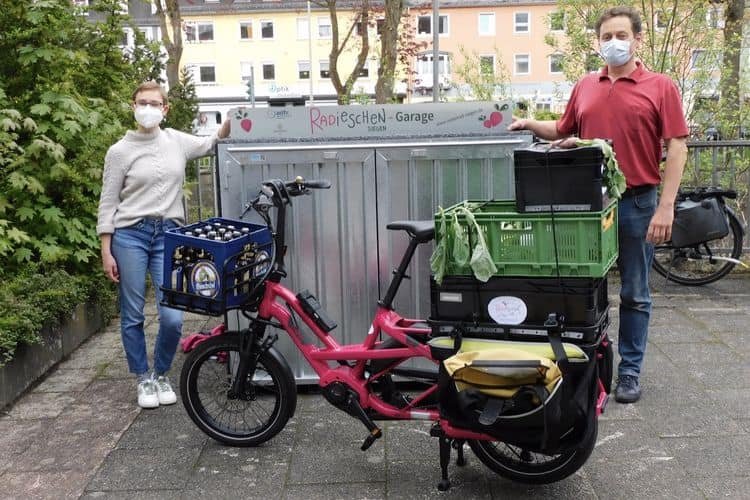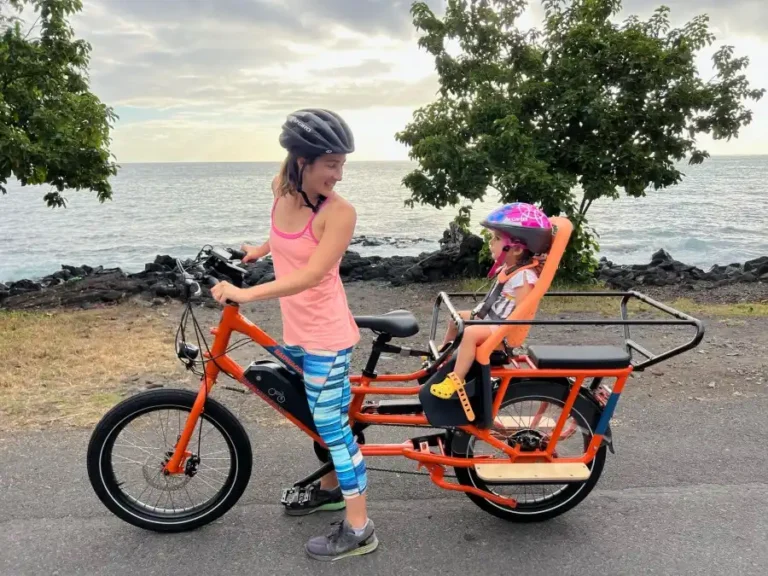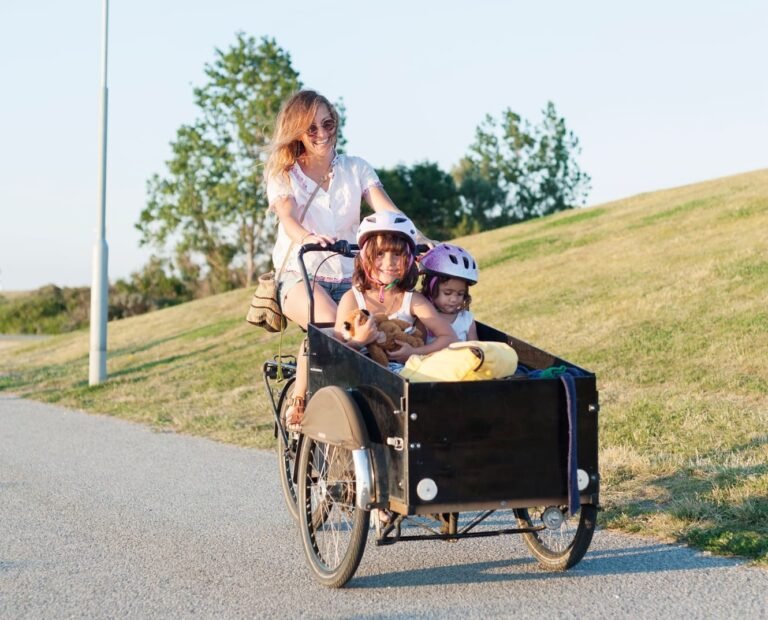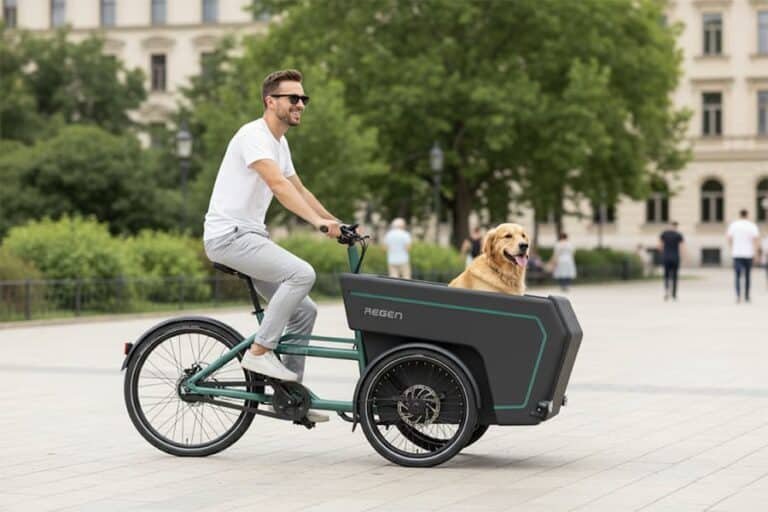No RegenComo fabricante profissional OEM/ODM de bicicletas de carga, auxiliamos frequentemente os clientes no desenvolvimento de ambos os modelos. Ao longo dos anos, entendemos que, independentemente do layout, sistema de direção é um dos elementos mais críticos do projeto de qualquer bicicleta de carga. Especialmente em bicicletas com carregamento frontal, a distância entre o guidão e a roda dianteira torna o uso de um mecanismo de direção direta convencional impraticável. Em vez disso, são necessários sistemas especializados para transferir a direção de forma eficaz.
Neste artigo, usaremos tanto conhecimento técnico quanto linguagem acessível para explicar os principais tipos de sistemas de direção utilizados em bicicletas de carga com carregamento frontal, detalhando os princípios, prós e contras e os casos ideais de aplicação de cada sistema. Também compartilharemos os aprendizados da Regen adquiridos ao longo de anos de experiência em engenharia.
O que é uma bicicleta de carga com carregamento frontal?
Uma bicicleta de carga com carregamento frontal é um tipo de bicicleta projetada especificamente para transportar mercadorias ou passageiros, com uma área de carga ou caixa posicionada à frente do ciclista. Estas bicicletas são frequentemente chamadas de Long Johns ou Bakfiets (holandês para “bicicleta com caixa”). A característica principal é uma seção de quadro estendida entre o guidão e a roda dianteira, onde a caixa ou compartimento de passageiros é montado.
Por outro lado, as Longtails são uma forma diferente de bicicleta de carga, onde o quadro é alongado na parte traseira. Esse design permite um bagageiro traseiro ampliado que pode transportar crianças, bagagem extra ou carga. Embora estruturalmente diferentes, tanto as Long Johns quanto as Longtails se enquadram na categoria geral de bicicletas de carga.
O valor fundamental das bicicletas de carga reside na sua capacidade de carga incomparável em comparação com as bicicletas convencionais. Seja para fazer compras de supermercado, levar a criança para a escola ou para logística urbana, as bicicletas de carga tornaram-se uma solução de transporte prática para famílias e serviços de entrega.

As bicicletas de carga com abertura frontal são particularmente populares entre famílias e entregadores urbanos, pois o ciclista pode ficar de olho na carga ou nas crianças durante o trajeto. As Long Johns geralmente apresentam duas rodas, um quadro dianteiro alongado e rebaixado para abrigar o compartimento de carga, enquanto as Longtails se assemelham a versões estendidas das bicicletas tradicionais, com uma seção traseira alongada para a montagem de assentos ou cestos.
O mecanismo de direção em bicicletas de carga com carregamento frontal
Numa bicicleta convencional, o guiador está ligado diretamente à forqueta dianteira — ao girar o guiador, a roda dianteira gira também. Este mecanismo de direção direta é simples e intuitivo. No entanto, nas bicicletas de carga com carregamento frontal, a caixa bloqueia o espaço entre o ciclista e a roda dianteira, tornando essa ligação direta inviável. Qualquer ligação direta entre guiador e forqueta teria de passar pela caixa, o que é impraticável.
Como resultado, os engenheiros desenvolveram mecanismos de direção indireta que utilizam um sistema intermediário para transmitir o movimento do ciclista à roda dianteira.
Ao projetar um sistema de direção para bicicletas de carga com carregamento frontal, vários desafios de engenharia devem ser abordados:
- Raio de viragem: A roda dianteira deve conseguir girar num ângulo suficientemente amplo para permitir manobras apertadas, especialmente em ambientes urbanos.
- Esforço de direção: O sistema deve continuar fácil de conduzir mesmo com cargas pesadas.
- Sensação de direção: A direção deve parecer precisa e estável, sem estar solta ou excessivamente sensível.
- Resistência estrutural e facilidade de manutenção: Os componentes devem suportar esforços e ser fáceis de manter.
Alguns sistemas de direção priorizam curvas fechadas e alta capacidade de resposta, enquanto outros se concentram na simplicidade e baixa manutenção. Abaixo, apresentamos os tipos de sistemas de direção mais comuns atualmente em uso:
- Direção Direta
- Direção de haste / direção de articulação
- Direção com suspensão basculante
- Direção por cabo
- Direção hidráulica
Examinaremos os princípios por trás de cada um, seus pontos fortes e fracos e os contextos em que são mais adequados.
Aqui está a tradução fluente e adaptada localmente para o inglês britânico do seu artigo técnico, mantendo o tom claro, profissional e fácil de ler, preservando todos os detalhes originais:
Direção Direta: A Solução Clássica de Cauda Longa
Nas bicicletas de carga tipo longtail, onde a carga é transportada atrás do ciclista e a roda dianteira permanece na posição habitual à frente do guiador, a maioria dos modelos utiliza o sistema de direção direta tradicional. Esta configuração é idêntica à de uma bicicleta comum: o guiador está rigidamente ligado à forquilha através do tubo de direção, e ao girar o guiador, a forquilha e a roda dianteira giram diretamente. Um conjunto de rolamentos de direção típico suporta a forquilha e a ação de direção é imediata e proporcional.

Vantagens da direção direta (direção por tubo de direção)
A direção direta é preferida pela sua simplicidade, fiabilidade e baixo custo de fabrico e manutenção. Sem mecanismos intermédios, há uma perda mínima de energia na transmissão de força. Os ciclistas beneficiam de uma resposta de direção precisa e intuitiva, e a condução assemelha-se à de uma bicicleta convencional — o que facilita a adaptação.
Este design adapta-se bem às bicicletas de carga longtail, pois a sua estrutura assemelha-se a uma bicicleta tradicional alongada, sem obstruções entre o guiador e a forquilha. A ausência de ligações adicionais também resulta numa estrutura mais leve e mais económica.
Limitações da Direção Direta
No entanto, a direção direta apresenta algumas limitações. Requer que o guiador e a forquilha estejam no mesmo eixo, o que limita a flexibilidade de design – especialmente nas bicicletas de carga com carregamento frontal, onde a caixa de carga obstruiria esse alinhamento.
Além disso, quando a parte dianteira está muito carregada — por exemplo, com um porta-bagagens cheio — a direção pode parecer mais pesada e exigir mais esforço do ciclista. Para compensar, algumas bicicletas elétricas longtail incluem estabilizadores ou amortecedores de direção (como amortecedores de mola) na direção para melhorar o manuseio com carga.
No geral, para bicicletas que não exigem designs frontais complexos, a direção direta continua sendo uma opção prática e de baixa manutenção. Verificações ocasionais e lubrificação dos rolamentos do fone de ouvido geralmente são suficientes — o que não é diferente da manutenção de uma bicicleta comum.
Nota: Como as bicicletas de carga com carregamento frontal raramente podem usar direção direta devido a limitações de espaço, os seguintes mecanismos de direção são mais relevantes para Long John ou designs semelhantes. Alguns também são aplicáveis a certos triciclos ou outras configurações especiais.
Direção por Articulação: Mecanismos Multi-Haste e Otimizações Especiais
Em contextos técnicos chineses, os termos “direção por haste” e “direção por articulação” são às vezes usados indistintamente. Para evitar confusão, aqui na Regen definimos direção de articulação como mecanismos geométricos mais complexos, com múltiplas hastes, ou melhorias especializadas na direção mecânica.
A maioria das bicicletas de carga com carregamento frontal requer apenas uma única haste para transmitir o movimento da direção. No entanto, alguns projetos avançados adotam hastes duplas ou combinações de múltiplas juntas para atingir desempenho geométrico específico ou soluções de embalagem. Por exemplo, uma configuração com dois braços de direção tanto na extremidade do guidão quanto na do garfo pode formar uma articulação paralela de quatro barras. Este design distribui as forças de direção de forma mais uniforme, melhora a estabilidade e ainda fornece um nível de redundância à prova de falhas—se uma haste falhar, a outra ainda poderá manter o controle parcial.
Outros sistemas inovadores introduzem cremalheira e pinhão ou junta universal mecanismos. Aqui, uma cremalheira conectada ao guidão gira um pinhão, que então transmite o movimento para o garfo dianteiro. Essa abordagem permite relações de direção ajustáveis, permitindo pequenos movimentos do guidão para atingir grandes ângulos da roda dianteira e suporta layouts totalmente integrados dentro do quadro da bicicleta. No entanto, esses sistemas tendem a ser mais complexos e caros de produzir, e são encontrados principalmente em montagens personalizadas ou projetos patenteados — e não em modelos de mercado de massa.
Prós e contras da direção de articulação
Comparado com configurações simples de haste única, a direção de múltiplas articulações permite maior flexibilidade de design e movimento mais suave. Por exemplo, alguns sistemas incorporam juntas universais nas extremidades das hastes para absorver deslocamentos verticais sutis durante a direção, garantindo um desempenho fluido e consistente. Os benefícios incluem sensação de direção ajustável e compatibilidade com várias geometrias de quadros. No entanto, o aumento da complexidade mecânica inevitavelmente traz mais pontos de falha potenciais e maiores necessidades de manutenção.
No Regen, normalmente consideramos projetos de multi-ligação para construções premium ou restrições de estrutura especiais. Um cliente, por exemplo, precisava de uma altura de caixa de carga ultrabaixa, o que inviabilizava uma haste reta. Projetamos uma rota de ligação curva, introduzindo juntas e pivôs extras para contornar obstáculos estruturais. Embora mais complexo e demorado para desenvolver, o resultado final forneceu manuseio direto e estável no mesmo nível de sistemas mais simples, provando que uma articulação bem calibrada ainda pode proporcionar excelente qualidade de condução.
Resumindo, a direção de articulação estende ainda mais o conceito de direção mecânicaAo prestar consultoria para montagens personalizadas, sempre avaliamos se tal complexidade é realmente necessária. Se uma configuração de haste única atender aos requisitos, preferimos manter as coisas simples. Mas quando projetos ou características especiais de estrutura exigem, temos a capacidade de fornecer sistemas multi-linkage robustos, garantindo funcionalidade aprimorada sem comprometer o controle ou a confiabilidade.
Direção por cabo: sistemas de cabos leves e flexíveis
Com os avanços nos materiais e na produção, as bicicletas de carga modernas começaram a adotar sistemas de direção por cabo-usando cabos de aço (semelhantes aos cabos de freio ou de câmbio) para transmitir a direção. O mecanismo funciona passando os cabos por polias ou guias, de modo que girar o guidão puxa ou solta os cabos, que então giram o garfo dianteiro. Normalmente, dois cabos são usados — um de cada lado. Girar para a esquerda puxa o cabo esquerdo, girando o garfo para a direita e vice-versa.
Como funciona a direção por cabo
Pense nisso como controle remoto via tambor e caboO guidão é conectado a um tambor ou polia rotativa com cabos enrolados em torno dele. Girar o guidão enrola um cabo e libera o outro. Na extremidade do garfo, um tambor correspondente traduz esse movimento em um impulso de direção. Os projetistas costumam ajustar os diâmetros das polias para controlar a relação de direção—por exemplo, permitindo que uma pequena volta no guiador gire a roda dianteira até 90°, como visto na Ca Go FS200.

Exemplo de imagem: Close-up do Yuba Supermarché mostrando seu sistema de direção de cabo duplo, completo com barris de ajuste de tensão em cada extremidade.
Vantagens da direção por cabo
A maior força da direção por cabo é sua flexibilidade no roteamento. Ao contrário das hastes de metal rígidas, os cabos podem dobrar e seguir curvas, tornando-os ideais para quadros com geometria apertada ou alturas baixas de passagem. Eles também se integram bem com garfos de suspensão, e manter o peso total baixo.
Além disso, graças à engenharia inteligente das polias, a direção por cabo geralmente oferece ângulos de giro muito grandes, permitindo que as bicicletas girem em espaços extremamente apertados - alguns dizem que ele se comporta "como um kart". Os sistemas de cabos premium podem incluir amortecedores embutidos e molas de centralização, dando à direção uma sensação suave e autoalinhante. Na Regen, quando os clientes exigem manuseio ágil em becos estreitos ou espaços urbanos densos, geralmente propomos a direção por cabo como uma opção, especialmente para aplicações de alta mobilidade.
Desvantagens e considerações de manutenção
Os sistemas de cabo têm desvantagens. Em primeiro lugar, a manutenção é mais exigente do que com hastes rígidas. Com o tempo, os cabos podem esticar ou afrouxar, exigindo retensionamento regular através de ajustadores de cilindro. Assim como os cabos de freio, eles precisam ser verificados periodicamente, especialmente após uso intenso ou longas distâncias.
Em segundo lugar, há um ligeiro atraso elástico na sensação da direção. Mesmo cabos enrolados firmemente podem apresentar uma leve folga, tornando a condução um pouco mais "suave" em comparação com a precisão sólida das bielas mecânicas. Embora a diferença seja pequena, pilotos experientes podem notá-la, principalmente em altas velocidades.
Além disso, a direção por cabo envolve mais componentes:polias, alojamentos, tensores, cabos de aço inoxidável—então é tipicamente mais caro e demorado para instalarEm casos raros, um cabo rompido ou uma polia emperrada podem causar perda parcial ou total da direção. Para evitar isso, modelos de ponta utilizam cabos redundantes duplos, fios mais grossos e intervalos regulares de substituição.
Melhores casos de uso
A direção por cabo agora é amplamente adotada em bicicletas de carga elétricas de última geração, que priorizam ambos elegância visual e controle responsivo. Marcas como Riese & Müller (Packster 70) e Ca Go (série FS) adotaram esta solução. Os engenheiros da Ca Go até descrevem sua direção como “semelhante à de um carro”, oferecendo curvas fechadas em cidades congestionadas.
Em Regen, se um cliente valoriza leve, manuseio compacto e design flexível, e está aberto a manutenção básica, como retensionamento de cabos, temos o prazer de recomendar a direção por cabo. Também explicamos as compensações de custo e manutenção de forma transparente, para que os clientes possam tomar uma decisão informada entre sistemas de hastes tradicionais e configurações de cabos modernas.
Direção com suspensão basculante: para triciclos e plataformas de carga de uso especial
Embora a maior parte deste artigo se concentre em bicicletas de carga de duas rodas com carregamento frontal, vale a pena abordar uma solução mais especializada que encontramos em projetos personalizados:direção com suspensão basculante. Este sistema é normalmente aplicado a triciclos de carga de três rodas ou veículos pesados com cabines fechadas, onde a estabilidade e o manuseio sob carga se tornam particularmente desafiadores.
Como funciona
A direção da suspensão basculante integra entrada de direção com um movimento de inclinação coordenado do chassis ou dos braços de suspensão do veículo. Quando o condutor gira o guiador, as rodas dianteiras giram normalmente, mas, ao mesmo tempo, o chassis principal ou o sistema de suspensão permitem que o veículo inclinar-se na curva, imitando a dinâmica natural de uma bicicleta de duas rodas.

Na maioria dos projetos, o mecanismo de inclinação é obtido por meio de:
- Braços de suspensão articulados ou pontos de articulação
- Amortecedores a gás ou hidráulicos para controlar o ângulo de inclinação
- Um sistema de bloqueio ou autocentralização para garantir a segurança em baixas velocidades ou quando parado
Essa configuração melhora a estabilidade ao deslocar o centro de gravidade para a curva, reduzindo o risco de tombamento, uma preocupação comum com triciclos de estrutura rígida, especialmente ao transportar cargas irregulares ou altas.
Casos de uso e nossa abordagem
Na Regen, apoiamos vários clientes no desenvolvimento veículos de carga elétricos de três rodas, como triciclos de entrega urbana ou plataformas logísticas totalmente fechadas. Nesses projetos, o sistema de direção geralmente requer mais do que apenas uma ligação mecânica — ele deve funcionar em conjunto com um sistema de suspensão que permite o rolamento controlado da carroceria.
Por exemplo, um cliente queria que seu triciclo de carga tivesse um desempenho confiável em curvas fechadas, transportando até 200 kg. Uma configuração de direção convencional com quadro fixo parecia instável em alta velocidade. Propusemos uma projeto de suspensão basculante, permitindo que o veículo se inclinasse para dentro ao virar. Também integramos um mecanismo de bloqueio hidráulico que é ativado em baixas velocidades para evitar oscilações ao parar ou estacionar.
Este tipo de sistema é complexo e requer simulação, prototipagem e testes cuidadosos. Mas, quando bem feito, oferece uma combinação única de agilidade em alta velocidade e segurança no transporte de carga—ideal para ambientes urbanos densos ou rotas de entrega estreitas.
Prós e contras
| Prós | Contras |
|---|---|
| Estabilidade de curva melhorada para triciclos | Alta complexidade de projeto e fabricação |
| Dinâmica de pilotagem mais natural | Componentes caros e ajustes necessários |
| Ajuda a evitar tombamento sob carga | Mais pesado e difícil de manter do que as configurações padrão |
Quando escolher a direção com suspensão inclinável
Normalmente recomendamos este sistema apenas para clientes com necessidades muito específicas-como:
- Triciclos de alta capacidade utilizados em logística comercial
- Veículos totalmente fechados onde as forças laterais durante as curvas são amplificadas
- Aplicações onde conforto de condução e controle de alta velocidade são críticos
Não é adequado para todos os projetos, mas para aqueles que ultrapassam os limites do design de veículos de carga, direção com suspensão basculante oferece vantagens convincentes. Como sempre, nós da Regen equilibramos inovação com praticidade — não sugerimos soluções complexas a menos que o valor agregado seja claro.
Direção Hidráulica: Conceitos Emergentes e Perspectivas Futuras
Uso de sistemas de direção hidráulica cilindros e tubos cheios de fluido para transmitir o movimento do guidão para a roda dianteira. Semelhante à direção hidráulica automotiva (mas sem a bomba), um sistema típico apresenta um cilindro mestre conectado ao guidão e um cilindro escravo no garfo, conectados por mangueiras de alta pressão. Girar o guidão comprime o fluido no cilindro mestre, forçando o cilindro escravo a se mover e girar o garfo.
Como os fluidos são incompressíveis e a pressão pode ser transmitida por meio de mangueiras flexíveis, os sistemas hidráulicos oferecem movimento preciso e responsivo com grande flexibilidade de layout — assim como cabos, mas com maior transmissão de força.
Situação atual e desafios
A direção hidráulica continua sendo uma conceito de nicho no mundo das bicicletas de carga. Alguns engenheiros já testaram protótipos, mas ainda não é uma opção popular. Os benefícios potenciais incluem:
- Roteamento de mangueira flexível, sem restrições de linhas retas
- Relações de torque e ângulo personalizáveis, através do ajuste do tamanho do pistão
- Efeitos de amortecimento integrados, graças à resistência do fluido
- Invólucro completo e resistência às intempéries
Dito isto, o sistema complexidade e custo são grandes barreiras. Requer componentes de precisão, linhas de fluido seladas e sangria de ar cuidadosa — muito semelhante a um sistema de freio hidráulico. Mesmo pequenas bolhas de ar podem afetar a sensibilidade da direção. Além disso, variações de temperatura podem alterar viscosidade do fluido, impactando a resposta da direção em condições climáticas extremas.
A manutenção também é um desafio: consertar vazamentos ou substituir as demandas de fluidos ferramentas e conhecimentos especiais. Se uma mangueira falhar, o desempenho da direção pode cair drasticamente, representando riscos à segurança.
Potencial Futuro
Apesar destes desafios, nós da Regen continuamos aberto para direção hidráulica para aplicações especiais, como triciclos pesados com cabines fechadas ou plataformas utilitárias onde o roteamento mecânico é impraticável. Olhando para o futuro, imaginamos a fusão de sistemas hidráulicos com controles eletrônicos, permitindo recursos como assistência de direção ou manutenção de faixa, semelhante à tecnologia automotiva.
Mas por enquanto, a direção hidráulica ainda está no estágio experimental, melhor deixar para inovadores e construtores entusiastas. A menos que um cliente solicite especificamente esta configuração e entenda completamente suas desvantagens, normalmente não a recomendamos para projetos de bicicletas de carga padrão.
Reflexões sobre o design da Regen: como escolhemos o sistema de direção certo para sua bicicleta de carga
Como fabricante OEM/ODM experiente, a Regen participou do desenvolvimento e otimização de diversos sistemas de direção para bicicletas de carga. Ao aconselhar clientes sobre escolhas de design, geralmente levamos em consideração os seguintes fatores-chave — e teremos prazer em compartilhar nossas ideias com você:
1. Segurança e confiabilidade em primeiro lugar
Independentemente do tipo de direção, a segurança do piloto é sempre nossa maior prioridade. Sistemas de hastes mecânicas destacam-se pela clareza e robustez, com menos pontos de falha. Direção por cabo usa redundância de cabo duplo para melhorar a segurança, enquanto sistemas hidráulicos, embora ainda não seja comum, pode ser protegido por meio de circuitos duplos ou válvulas de segurança.
Na Regen, projetamos com margens de segurança e usamos materiais de qualidade automotiva para juntas críticas. Por exemplo, nossas extremidades de haste utilizam juntas esféricas testadas contra fadiga, semelhantes às encontradas em sistemas de direção de automóveis. Nossos cabos de direção são revestidos com linhas de nível aeroespacial com tecnologia anti-estiramento e bainhas de segurança integradas. Esses detalhes garantem que sua bicicleta de carga permaneça confiável, mesmo sob uso intenso e prolongado.
2. Sensação de manuseio: precisão vs. agilidade
Diferentes clientes preferem características de direção diferentes. Alguns priorizam uma dirigibilidade leve e responsiva, enquanto outros valorizam uma sensação mais firme e estável, especialmente quando totalmente carregados. Os sistemas baseados em hastes geralmente oferecem uma resposta mais sólida e direta, ideal para cargas mais pesadas ou velocidades mais altas. A direção por cabo, com seu feedback ligeiramente elástico, é adequada passeio urbano leve e ágil.
Ajustamos a geometria — como comprimentos de braço e dispositivos de amortecimento — para atender a essas necessidades. Por exemplo, um cliente relatou que sua antiga bicicleta de carga parecia "instável" ao ser descarregada. Redesenhamos o sistema de hastes para incluir uma mola de retorno de luz, melhorando a centralização sem comprometer a sensibilidade. Da mesma forma, nossas configurações de cabos incluem tensores de pré-carga e arruelas de amortecimento para manter o controle em altas velocidades. Esses refinamentos são resultado de anos de experiência prática.
3. Requisitos de ângulo de giro e geometria
As bicicletas de carga de uso urbano geralmente exigem uma raio de giro apertado para navegar em ruas e caminhos estreitos. A direção por cabo tem uma vantagem aqui, permitindo até 90° de rotação da roda dianteira. Sistemas baseados em hastes são mais limitados por restrições mecânicas, embora um projeto de layout cuidadoso ainda possa atingir ângulos respeitáveis.
Na Regen, calculamos o ângulo necessário da roda dianteira com base no raio de giro desejado pelo cliente. Se um sistema de biela não atender a esse requisito, nós o faremos. propor alternativas de forma transparentePor exemplo, um cliente precisava que sua bicicleta de carga de duas rodas fizesse uma curva em U em um beco de 3 metros. Depois de testar opções com haste, mudamos para direção por cabo, o que proporcionou a agilidade necessária.
4. Manutenção e Experiência do Usuário
Os operadores comerciais, como as frotas de entrega, tendem a valorizar sistemas de baixa manutenção, enquanto usuários particulares podem priorizar a qualidade da viagem, mesmo que isso signifique manutenção ocasional. É por isso que adaptamos o sistema ao usuário.
Para bicicletas compartilhadas ou de frota, geralmente recomendamos o configuração de haste mecânica por sua durabilidade sob manutenção inconsistente. Para bicicletas familiares de alta qualidade, podemos oferecer direção por caboe forneça instruções claras para o ajuste da tensão do cabo — assim como verificar a pressão dos pneus, é uma etapa rotineira, mas fácil.
O manual do usuário do Supermarché da Yuba, por exemplo, orienta explicitamente os ciclistas sobre como apertar o cabo para remover a folga da direção. Seguimos a mesma filosofia: um ótimo design deve ser fácil de manter. Cada produto que desenvolvemos vem com um plano de manutenção e um layout otimizado para fácil acesso e ajuste—isso é parte do valor agregado que o Regen fornece como um ODM.
5. Custo e complexidade do sistema
Finalmente, o custo é importante. Os sistemas baseados em hastes são os mais econômico, graças à sua construção simples e facilidade de produção em massa. Os sistemas de cabos requerem mais peças personalizadas (polias, tensores, etc.) e ajuste adicional durante a montagem, resultando em custos mais elevados. A direção hidráulica, por enquanto, continua sendo a mais caro e complexo.
Quando o orçamento é apertado, aconselhamos soluções práticas. Por exemplo, em um lote de bicicletas elétricas de carga de nível básico, adotamos uma configuração de haste clássica, economizando o dinheiro do cliente. dezenas de dólares por unidade mantendo o desempenho. Por outro lado, para produtos premium que buscam exclusividade, estamos abertos a investir mais, como oferecer varas de fibra de carbono ou roteamento de cabos internos—para elevar o valor do produto.
Conclusão: Explore o que é possível — Crie o que é seu
As bicicletas de carga com abertura frontal são um segmento único e cada vez mais popular no mundo do ciclismo. Das clássicas Long Johns aos modernos modelos com assistência elétrica e direção avançada, a inovação é constante. O sistema de direção atua como sistema nervoso dessas motos — elas moldam o manuseio, o caráter e a confiança do piloto.
Neste artigo, explicamos os principais sistemas de direção para bicicletas de carga:haste, ligação, cabo e sistema hidráulico— tanto em termos técnicos quanto práticos. Também compartilhamos os insights de design do Regen sobre o mundo real, extraídos de inúmeros projetos de clientes e testes de engenharia.
Como empresa dedicada ao setor de bicicletas de carga, a Regen acolhe com entusiasmo a colaboração e a partilha de ideias. Quer esteja a planear um novo modelo ou a atualizar um já existente, estamos aqui para o ajudar a explorar as opções certas. Se preferir a confiabilidade clássica das hastes, ou você está intrigado com o agilidade fluida da direção por cabo ou hidráulica, temos a experiência para apoiar sua decisão.
Vamos construir algo sob medida, durável e verdadeiramente seu. Com o sistema de direção certo e a expertise da Regen, sua bicicleta de carga pode ser tudo o que precisa ser: segura, suave e pronta para tudo.
Referência
- Ricardo, “Como ele dirige?”, A Bakfiets Cargobike
- Criggie, “Bicicleta de carga com articulação de direção”, Bicicletas StackExchange
- Ca Go Bike, “Quais são os benefícios do sistema de direção Ca Go FS (cabo)?”
- Revista Downtown, “Análise do Ca Go FS 200 Vario”
- Ebike24, “Ca Go FS200: O sonho da Cargobike feita de espuma”
- rtyler, “Apertando a direção para um Supermercado Yuba”
- Revista Cargobike, “Ca Go: O novato ousado”
- Henry@Ciclos de Trabalho, “Instruções de remontagem de bakfiets WorkCycles Kr8”
- Fórum CustomFrame, “Bicicleta de carga com direção central”






